
views
Formatting Your Postcard

Pick out a postcard that represents you or your travels. One of the best parts of postcard writing is picking out the postcard image. Think about the person you are sending the postcard to and decide which image they would like best. Tip: If you are travelling, find a postcard with a photograph of your favorite place so far on your trip. Postcards can be found at any souvenir store, grocery stores, or on the streets of popular tourist areas.
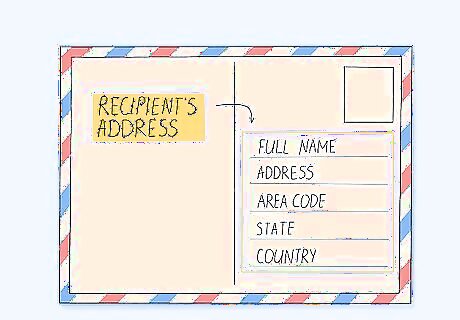
Write a message on the back of the postcard, on the left side. Flip the postcard over. You will see a vertical line down the middle of the card, with a blank space on the left, and a lined space on the right. Write your desired recipient's address on the lined space to the right of the line. This includes their full name, address, area code, state, and country. Do not write on the front of the postcard, as the postal service won’t look for information on the front. Make your writing as clear and legible as possible. Use a ballpoint pen rather than a felt tip pen; it is less likely to smear if it gets wet.
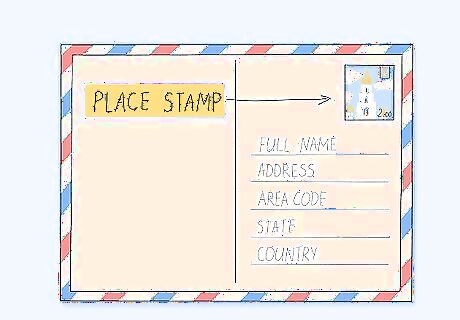
Place the stamp on the top right of the postcard. Purchase stamps from the country you’re in from banks, post offices, or gas stations. If you are abroad and need a stamp from your home country, you can order them online. Lick the stamp and place in within the outlined box on the top right of the postcard. You can purchase stamps at any post office. Make sure that you put the stamp in the back of the postcard in the top-right corner. Putting it anywhere else increases the chances of the card getting lost.
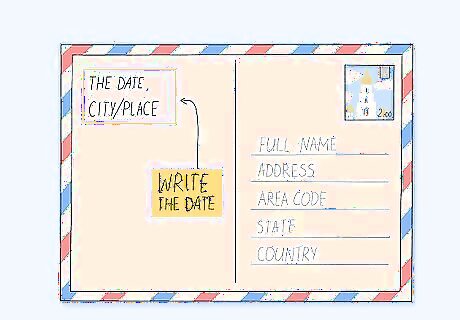
Write the date on the top-left corner on the back of the postcard. This is a great way for people to reminiscence later on in life when revisiting your postcard. Under or above the date, you can also write the city or specific place you are writing from. For example, you could write: July 4, 2017 Grand Canyon, Arizona
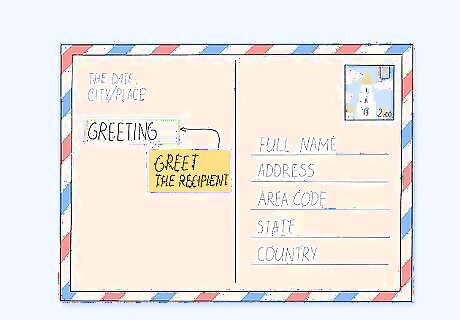
Greet the recipient on the left side. A greeting will make your recipient feel special and appreciated, while also giving the postcard a heartfelt, letter-esque feel. Writing the greeting on the top left of the back side of the postcard, leaving room for the note below it. If you want to be formal, write: “Dear, (name)." If you want to be less formal, you could start with “Hello, (name)!"
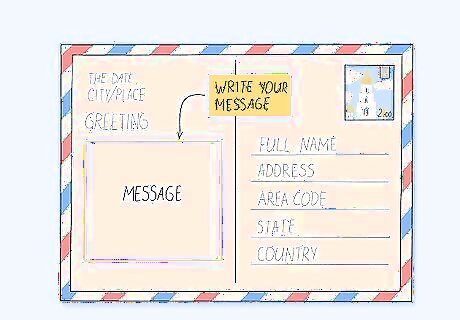
Write your message on the left side. Postcards are exciting because of the restrictions that are put on your writing, as the message must be short and sweet. While writing on the left side of the postcard, be sure to give yourself enough space and plan what you are going to write. You don’t want to run out of space in the middle of a thought!Tip: After writing your message, do not forget to sign your name on the bottom left of the postcard, too.
Writing the Postcard
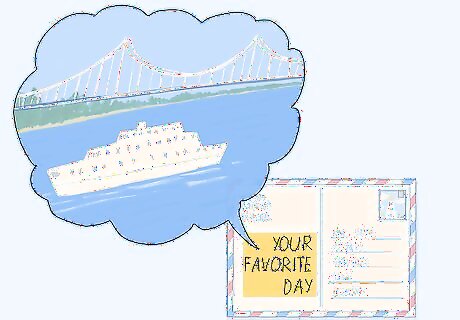
Recount your favorite day of your trip. Because postcards are small, it is difficult to recount your entire trip. Describing your favorite day, or a favorite memory will ensure that you don’t run out of space. Tell the recipient what you loved about the day, and what made the day specifically stand out to you. Add as many details as possible but be conscious of how much room you have. If the card is from a specific place on your trip, such as the Grand Canyon, consider limiting your description to that place. You can always send more postcards from other places.
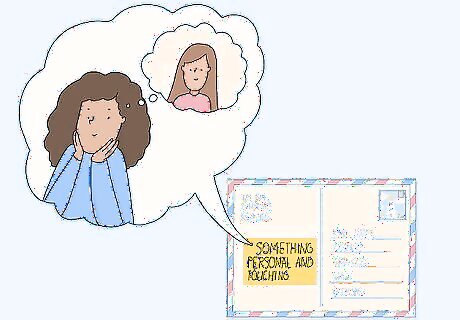
Say something personal and touching. Tell the person that you miss them or that you’ve been thinking about them during your travels, and that you are excited to see them again. A good thing to start your postcard with is:Tip: Beginning with your thoughts of the other person will make them feel loved. “I’ve been thinking about you." “I wish you were here with me!”
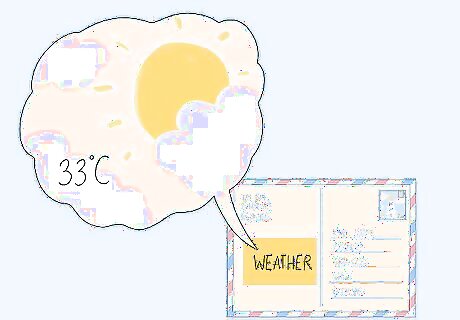
Let the person know how the weather has been. Describe a day with especially interesting weather, if it rained or snowed, or describe how beautiful the weather has been. Giving the recipient an idea of what weather conditions are like will make them feel closer to you.PNote: You don't have to be detailed. Something short, like "It is so hot here!" or "It was so cold, I needed two coats!" would be plenty.

Write about your favorite meal of the trip. Let them know where you ate the meal, what you ordered, and how it tasted. Getting into detail about the specific meal you ate will give them a vivid image of your trip and allow them to relate to your experiences in a new way. This is not absolutely necessary, but it's a great idea if the meal is something that the location is famous for.
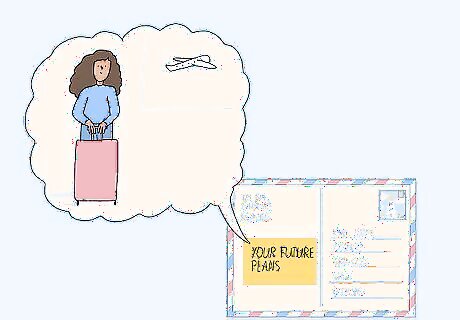
End the postcard with your future plans. Whether you are planning to travel on to a new location or heading back home soon, letting the recipient know your plans is always a good thing to do in a postcard. Make a short itinerary of the rest of your trip, or at least a loose structure, so that they know where you will be in the future. If you plan to head home soon, end the card with, “I’ll see you soon,” or, “I can’t wait to see you!”
Avoiding Common Mistakes
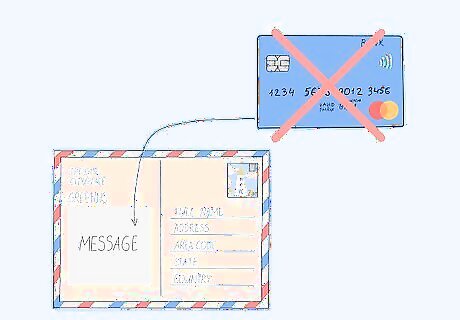
Do not write about anything too personal. Because the back of the postcard is exposed, anyone who picks up your postcard will be able to see what you have written. Avoid writing things that you wouldn’t tell a stranger, like personal bank information, intimate secrets, or anything that could be used to steal your identity.Tip: If you need to write to someone about something personal, consider writing a letter instead. Remember, the information on the back of the postcard is visible.
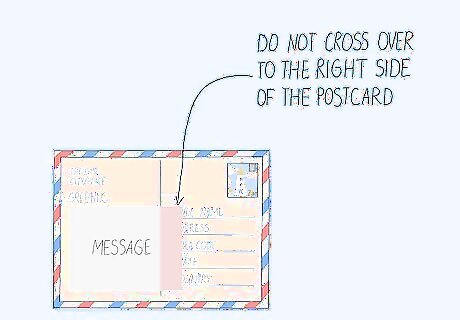
Do not let your writing cross over to the right side of the postcard. Keeping your writing on the left side of the postcard is very important in ensuring that the postcard makes it to its destination. Creeping into the address part of the postcard (the right side) could make the address difficult to read and could throw off the post office. If you have too much to write about, consider sending a letter in addition to the postcard. Keep the message short and brief on the card, and write a longer message in a letter.
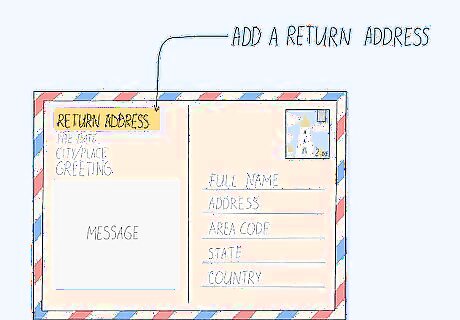
Add a return address if you will be in one place for a while. Write the return address on the top left of the postcard. If you plan to be travelling within a month of sending the postcard, write the return address of your next destination. Return addresses are best if you know exactly where you will be over time.Tip: If you will be moving a lot during your trip, skip the return address. By the time the person receives your postcard and sends a letter back, you may have moved on.
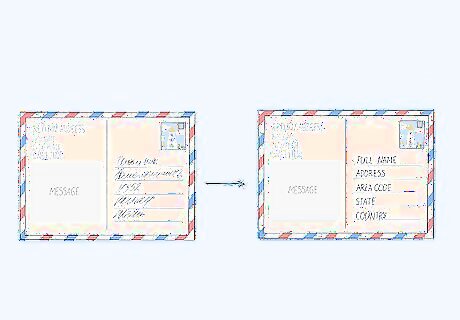
Write legibly, especially with addresses. Sloppy or illegible handwriting may result in the post office sending your postcard to the wrong place, or discarding because of bad handwriting. If you are worried about your handwriting, practice writing the address in print on scrap paper before transcribing it to the postcard. Be sure to write legibly for both the recipient address and the return address. The note itself does not have to be too neat, as long as your recipient can read it.



















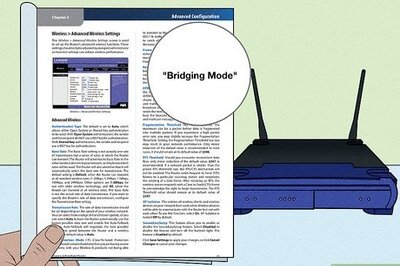
Comments
0 comment